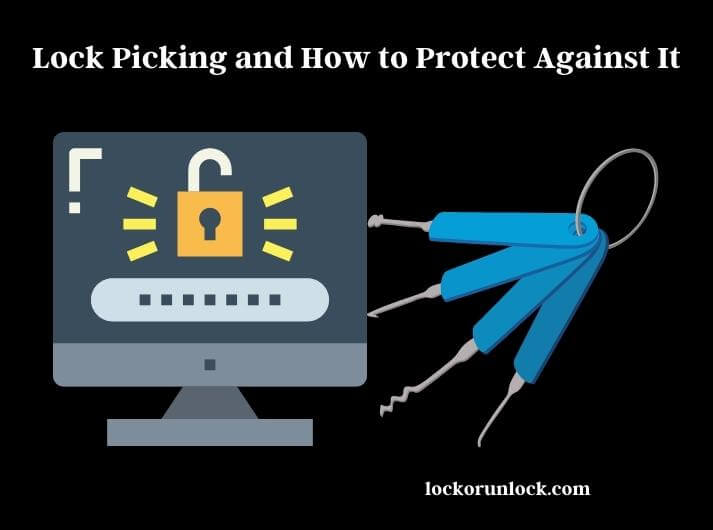Locks are one of the most common and important security measures used to protect our homes, cars, and other valuable possessions. They provide us with a sense of safety and security, but unfortunately, locks are not always enough to keep intruders out.
Lock picking is a skill that allows individuals to gain unauthorized access to locked areas or items. It involves manipulating a lock’s components to bypass its locking mechanism without using the correct key. Lock picking is not just a problem for homeowners; businesses, governments, and other organizations also face the threat of lock picking.

In this day and age, where information is readily available online, anyone can learn how to pick a lock. There are countless YouTube tutorials, online forums, and even lock-picking kits available for purchase. As a result, it’s essential to understand what lock picking is and how to protect against it.
Lock Picking
Lock picking is the skill of opening a lock without using the proper key. It involves manipulating the pins or tumblers inside the lock to align them and allow the lock to be turned. Lock picking can be used for both legal and illegal purposes, such as gaining entry to a locked room or stealing from a locked safe.
Lock picking requires specific tools, such as picks and tension wrenches, as well as knowledge of how locks work and how to manipulate their internal mechanisms. There are many different techniques and methods of lock picking, and it can take years of practice to become proficient.
Lock picking can be used to gain access to a wide range of locks, from simple padlocks to complex electronic locks. However, there are also many ways to protect against lock pickings, such as using high-quality locks, installing deadbolts, and using security pins or lock guards.
While lock picking can be a useful skill for locksmiths, security professionals, and law enforcement, it can also be used by criminals to gain entry to homes, businesses, and vehicles. It is important to be aware of the potential risks and take steps to protect against lock picking.
Types of Locks
There are many types of locks, including padlocks, deadbolts, and electronic locks. Each type of lock has its own vulnerabilities, and it’s essential to understand them to protect against lock picking.
For example, padlocks are susceptible to shimming, where a thin piece of metal is inserted between the lock’s shackle and body to bypass the locking mechanism.
Tools Used in Lock Picking
Lock picking requires specific tools that are designed to manipulate the lock’s components and open it without using the correct key. There are many different tools used in lock picking, each with its own unique purpose. Here are some of the most common tools used in lock picking:

Picks – Lock picks are thin, pointed tools used to lift individual pins or tumblers inside the lock. They come in different shapes and sizes, and each pick is designed to manipulate a specific type of lock.
Rakes – Rake tools are used to move multiple pins at once inside the lock. They have a series of jagged edges that are inserted into the lock and then pulled back and forth to move the pins.
Tension wrenches – Tension wrenches are used to apply tension to the lock’s cylinder. This tension allows the pins or tumblers to be manipulated using the pick or rake tools.
Bump keys – Bump keys are specially designed keys that can be used to open some types of locks by bumping the pins into place. Bump keys are cut in a way that allows the pins to be moved by striking the key with a blunt object such as a hammer.
Tension bars – Tension bars are used to apply tension to the lock’s cylinder, much like tension wrenches. Tension bars are typically used in combination with other tools, such as picks or rakes, to manipulate the lock’s components.
Pick guns – Pick guns are small handheld devices that use a spring-loaded mechanism to rapidly strike the pins inside the lock, allowing them to be moved into the correct position to open the lock.
Techniques Used in Lock Picking
Lock picking involves a variety of techniques to manipulate a lock’s components and open it without using the correct key. Here are some of the most common techniques used in lock picking:
Single Pin Picking
Single-pin picking involves using a pick tool to individually lift each pin or tumbler inside the lock to the correct height to align with the lock’s shear line. Once all pins are correctly aligned, the lock can be opened.
Raking
Raking involves using a rake tool to rapidly move multiple pins or tumblers inside the lock at the same time. The rapid movement of the rake tool can sometimes cause the pins or tumblers to jump into position and align with the shear line, allowing the lock to be opened.
Bumping
Bumping involves using a specially designed key, called a bump key, to rapidly bump the pins inside the lock. The force of the bump can sometimes cause the pins to jump into position and align with the shear line, allowing the lock to be opened.
Impressioning
Impressioning involves inserting a blank key into the lock and manipulating it until it creates a pattern of marks on the key. These marks can then be used to create a working key for the lock.
Decoding
Decoding involves using a decoder tool to determine the correct key combination for the lock. Decoder tools work by measuring the spacing between the pins or tumblers inside the lock to determine the correct key.
How to Protect Against Lock Picking
Lock picking is a skill that allows a person to gain unauthorized access to locked spaces or objects by manipulating the locking mechanism. If you want to protect against lock picking, there are several measures you can take:
Use High-Quality Locks
Choose locks that are difficult to pick, such as those with complex keyways, multiple pins, and advanced security features. Look for locks that are rated as “pick-resistant” or “high-security” by independent testing organizations.
Install Deadbolts
Deadbolts are more secure than spring-latch locks because they cannot be easily jimmied open. Make sure to install them correctly, with screws that are at least 3 inches long.
Upgrade Your Door and Frame
Make sure your door and frame are strong and secure. A weak door or frame can be easily kicked in, bypassing any lock.
Use Security Pins
Some locks can be retrofitted with security pins, which are designed to make picking more difficult. These pins have irregular shapes or angles, making them harder to manipulate.
Install a Lock Guard
A lock guard is a metal plate that covers the lock and prevents it from being accessed or damaged by tools such as hammers, saws, or pliers.
Consider an Electronic Lock
Electronic locks can be more difficult to pick than traditional locks. They can also provide additional security features, such as alarms or automatic locking.
Use Surveillance Cameras
Installing surveillance cameras can help deter criminals and provide evidence in case of a break-in.
Be Aware of Your Surroundings
Make sure to keep an eye out for suspicious activity and report any concerns to the police. Don’t hesitate to ask for help or advice from security professionals.
How Can I Protect Myself Against Lock Picking and Bypass Techniques?
To protect yourself against lock picking and bypass techniques, it’s essential to use high-security locks that are resistant to these methods. Educate yourself on how these techniques work by referring to an indepth guide to bypass locks. Stay informed and invest in quality security measures to safeguard your belongings.
Conclusion
lock picking is a skill that can be used for both good and bad purposes. While it can be a valuable tool for locksmiths, law enforcement, and security professionals, it can also be used by criminals to gain unauthorized access to buildings, homes, and vehicles.
To protect against lock picking, there are several measures that individuals can take. Choosing high-quality locks, installing additional security features such as deadbolts and reinforced strike plates, and using smart locks with advanced encryption and authentication are all effective ways to deter lock pickers.
Be aware of common lock-picking techniques and to practice good security habits such as not leaving spare keys in obvious locations and changing locks after a break-in.

I must express my thanks to this writer for bailing me out of this dilemma. Just after surfing around throughout the search engines and obtaining things which were not powerful, I thought my entire life was done. Existing without the presence of approaches to the difficulties you have fixed by way of your entire posting is a crucial case, as well as ones which may have adversely affected my career if I hadn’t discovered your site. The natural talent and kindness in dealing with all the pieces was precious. I am not sure what I would have done if I had not come upon such a step like this. I’m able to at this moment look ahead to my future. Thanks for your time very much for your skilled and effective guide. I will not think twice to refer the sites to anyone who wants and needs guide on this issue.